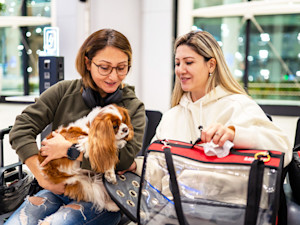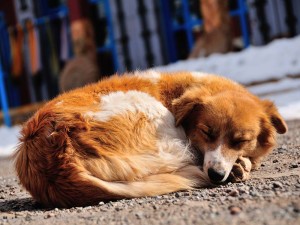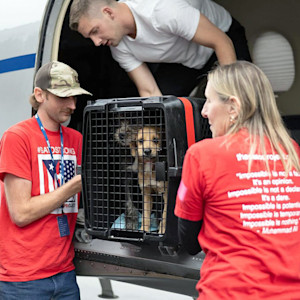The Mystery of the Blue Dogs at Chernobyl Has Been Solved
It’s not what you might think.

Share Article
Wait, are the dogs of Chernobyl turning blue? Viral videos certainly make it seem that way. Earlier this month, the official Instagram account for Dogs of Chernobyl,opens in new tab the non-profit that monitors the stray dogs in the area, posted a video of some dogsopens in new tab with a unique neon hue to their fur. Across the internet, debates erupted about the potential cause — many assumed it was the result of lingering nuclear radiation from the 1986 disaster, while others wrote it off as an AI filter. Neither guess was right.
First of all, the good news: The dogs aren’t exhibiting some latent radioactive mutation. The truth is somehow weirder. These pups have been romping around in bright blue chemical fluid that had leaked from an old, broken porta potty.
Dr. Jennifer Betz, the veterinary director for the Dogs of Chernobyl program, spoke to IFLScienceopens in new tab about the dogs’ peculiar coloring. “They appear to have been rolling in a substance that had accumulated on their fur,” she said. “We are suspecting that this substance was from an old portable toilet that was in the same location as the dogs; however, we were unable to positively confirm our suspicions.”
Dr. Betz emphasized that the blue hue was not related to Chernobyl radiation. And even though it looks alarming, the researchers insist that the dye job is superficial.
“The dogs appear healthy, as do all of the other dogs that we have encountered during our time in Chernobyl. I would suspect, as long as they don’t lick the majority of the substance off of their fur, it would be mostly harmless,” said Dr. Betz.
The Dogs of Chernobyl initiativeopens in new tab, which is a branch of the environmental support nonprofit Clean Futures Fund, has been monitoring stray animals in the area since 2017. The nuclear disaster in 1986 forced many residents to abandon their pets; the dogs living there today are the descendants of the ones left behind. Despite all odds, the dogs have managed to adapt to life in the “exclusion zone,” a 19-mile radius around the plant which is still considered unsafe for human habitation.
The Clean Futures Fund estimates that there are over 700 dogs (and 100 cats!) living in Chernobyl and the surrounding areas at any given time. The Dogs of Chernobyl group brings in veterinarians, scientists, and volunteers from all over the world to help care for the animals by feeding them, providing veterinary care, and spaying and neutering them.
Dr. Betz clarified to IFLScience that the blue coloration was not due to the occasional temporary markers that the Dogs of Chernobyl team uses to identify the dogs. These markers can be seen in some of the videosopens in new tab posted by the Instagram account.
“During our sterilization campaign, we apply a temporary crayon marker on the top of their head in the color green, red, blue or purple, to identify which dogs we have recently performed surgery on,” she said. “This washes off in two to three days. This coloring is only on top of their head and is completely different from the dogs that we encountered that were almost covered head to toe in blue substance.”
The Dogs of Chernobyl organization relies on fundraising to purchase medical supplies, vaccines, and food for the dogs in the Chernobyl Exclusion Zone. You can donate at the link below.

Petrana Radulovic
Petrana Radulovic is a New York City-based writer who focuses on entertainment and culture beats. In her free time, she writes fiction, sings karaoke, and tries new recipes. Her work has appeared in Polygon, IGN, Reactor, and more. She lives with a very affectionate cat named Bagel, who loves head kisses and meeting people at parties. He is smart enough to open cabinets but still too dumb to understand stairs.
Related articles
![A woman making a kiss face next to a dog.]()
10 Brands That Donate to Animal Rescues
Spend your hard-earned cash on fashion, beauty, and lifestyle brands that support worthy causes.
![Woman and her two cats from Stray Cat Alliance, LA.]()
Calling All LA Cat Lovers
If you can adopt, foster, or donate, Stray Cat Alliance needs your help to care for a “tsunami of kittens.”
![Women waiting for their flight at the airport with their dog.]()
Why You Should Adopt a Dog From (or Donate to) an International Rescue Organization
Without the advocacy they need, these animals rely on Americans for help.
![Woman volunteering and holding dog.]()
How to Turn Your Vacation Into an Opportunity to Help Local Rescue Animals
Split your time sipping cocktails by the beach and being a “voluntourist” for puppies and kittens in need.
![Stray dog sleeping on the street]()
Four Things to Do If You Want to Adopt a Dog From Another Country
Fall in love abroad? Follow these simple steps to bring your new family member home.
![a dog in a crate being carried onto a plane by volunteers]()
Want to Help a Rescue Pet Get to Their New Home? Become a Transport Volunteer
Domestic and international transport volunteers are in high demand—here’s how you can become one.





